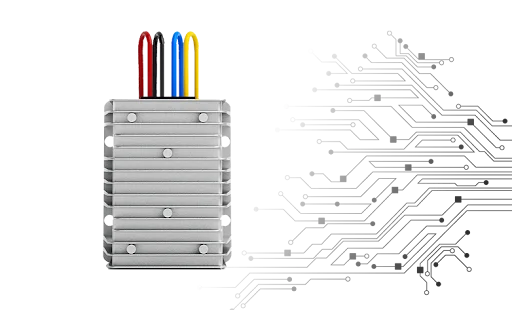Modern electronics, from smartphones to industrial equipment, rely heavily on efficient power conversion. One of the most important technologies making this possible is isolated step-down voltage converters. These converters not only reduce high DC voltages to lower usable levels but also ensure safety and noise immunity through electrical isolation. Their use is spreading rapidly across industries where reliability, safety, and performance are top priorities. In this article, we’ll dive deeply into their principles, types, design considerations, advantages, applications, and future trends.
Liked this? You’ll love what’s waiting in our related post selection.
What is an Isolated Step-Down Voltage Converter?
Isolated step-down voltage converters are a type of DC-DC converter designed to lower input voltage to a desired output level while maintaining galvanic isolation between the input and output. This separation is achieved using a transformer that prevents direct electrical contact. Unlike non-isolated converters, these provide an added layer of protection, which makes them suitable for critical systems. They are widely used where both voltage regulation and safety are equally important.
Why Isolation Matters in Power Conversion
Isolation is one of the most important aspects of power conversion. It provides user safety by preventing high voltages from reaching the output side, especially in sensitive systems. Isolation also reduces electromagnetic interference (EMI), which can disrupt circuit performance. Additionally, it prevents ground loop problems, which often cause signal distortions and unwanted currents. This combination of benefits ensures long-term reliability in demanding applications.
Basic Working Principle
The operation of an isolated buck converter involves three main stages. First, the input DC voltage is converted into high-frequency AC using switches such as MOSFETs or IGBTs. Then, a transformer steps down the voltage while maintaining isolation. Finally, rectifiers and filters convert the stepped-down AC back into stable DC. This process makes it possible to design efficient, compact, and safe power conversion systems.
Step-Down Voltage Conversion Explained
The step-down process is achieved by controlling the transformer’s turns ratio. For example, a 10:1 turns ratio would reduce 100V to 10V before rectification. This makes it easy to adapt high supply voltages to lower operating levels.
Role of Transformers in Isolation
Transformers are at the heart of isolated converters. They not only step down voltage but also ensure there is no direct electrical connection between input and output. This provides safety and prevents faults from spreading.
Types of Isolated Step-Down Converters
Isolated step-down voltage converters come in several topologies, each optimized for certain power levels and applications. Choosing the right topology depends on design requirements like efficiency, size, and cost.
Flyback Converter
The flyback converter is one of the simplest isolated designs, often used in low to medium power applications. It stores energy in the transformer during one part of the cycle and releases it during another. This simplicity makes it cost-effective but slightly less efficient compared to other designs.
Forward Converter
Forward converters directly transfer energy through the transformer, rather than storing it. This results in higher efficiency, especially at medium power levels. They are often used in industrial equipment where reliability is crucial.
Push-Pull Converter
Push-pull converters use two switches to drive the transformer alternately. This allows symmetrical operation and improves efficiency. They are ideal for automotive systems and medium-power applications.
Half-Bridge Converter
Half-bridge converters strike a balance between performance and cost. They use two switches and capacitors to split the voltage, driving the transformer efficiently. These are used in communication systems and industrial drives.
Full-Bridge Converter
Full-bridge converters use four switches, enabling them to handle high power with high efficiency. They are commonly used in renewable energy systems, electric vehicles, and heavy industrial applications. While more complex and expensive, their performance makes them indispensable in demanding systems.
Key Components in Isolated Step-Down Converters
The performance of an isolated converter depends on its components. Each plays a vital role in ensuring efficiency, safety, and stability.
Transformer Design
The transformer defines both voltage scaling and isolation. Its turns ratio determines the output voltage, while insulation ensures safety. High-frequency transformers are used to make designs more compact.
Switching Devices (MOSFETs, IGBTs, GaN, SiC)
Switching devices regulate energy transfer by rapidly turning on and off. Modern materials like GaN (Gallium Nitride) and SiC (Silicon Carbide) improve efficiency and reduce heat, making them suitable for high-performance converters.
Control ICs and Feedback Systems
Control ICs monitor the output voltage and adjust switching accordingly. Feedback systems ensure the output remains stable under changing loads, providing reliable performance.
Design Considerations
Designing isolated converters requires attention to electrical, thermal, and mechanical factors.
Voltage and Current Ratings
Choosing the correct voltage and current ratings ensures the converter operates safely within limits. Overestimating ratings increases cost, while underestimating risks failure.
Efficiency Optimization
Techniques like synchronous rectification, optimized switching frequencies, and GaN devices help maximize efficiency. High efficiency reduces energy waste and lowers operating costs.
Thermal Management Techniques
Heat is one of the biggest challenges in power electronics. Designers use heat sinks, forced air cooling, or advanced materials to keep temperatures under control. Poor thermal management can shorten the lifespan of the converter.
Advantages of Isolated Step-Down Converters
Isolated converters offer unique benefits that make them indispensable in critical systems.
Electrical Isolation for Safety
Isolation ensures users and sensitive electronics are shielded from high voltages. This makes them essential in medical and automotive systems.
High Flexibility in Design
Isolated converters can be customized for a wide range of applications, from low-power consumer devices to high-power industrial systems. Their modular nature allows engineers to adapt them to different needs.
Scalability for Different Power Levels
These converters can be scaled up or down to suit specific power requirements. Whether it’s a 10W charger or a 10kW industrial supply, isolated converters can be designed accordingly.
Challenges and Limitations
Despite their advantages, isolated converters also present some drawbacks.
Higher Cost vs. Non-Isolated Converters
The inclusion of transformers and additional circuitry makes them more expensive. For low-cost consumer products, non-isolated converters may be preferred.
Transformer Size and Weight
Transformers add bulk, making designs larger and heavier. This is a limitation for portable devices where size matters.
Complex Design Requirements
Designing with transformers requires expertise in magnetics and switching. This complexity increases development time and cost.
Applications of Isolated Step-Down Voltage Converters
These converters are used across many industries, thanks to their balance of safety and performance.
Consumer Electronics (Laptops, Chargers, Adapters)
Laptops, phones, and televisions often use isolated converters to safely adapt wall power into usable voltages. Their compact designs make them ideal for daily use devices.
Industrial Power Supplies
Factories use isolated converters to power motors, sensors, and control systems. Their reliability ensures uninterrupted operation in demanding environments.
Medical Equipment (Strict Safety Compliance)
In medical systems, patient and operator safety is critical. Isolated converters prevent dangerous leakage currents, ensuring compliance with strict safety standards.
Conclusion
Isolated step-down voltage converters are vital for safe, reliable, and efficient power conversion across multiple industries. While they may involve higher cost and design complexity, their safety and flexibility far outweigh these drawbacks. With advancements in wide bandgap semiconductors and digital control, their role will only expand in the future, making isolated DC-DC buck converters an indispensable part of modern electronics.
Don’t miss this featured post—it’s what everyone’s talking about.







